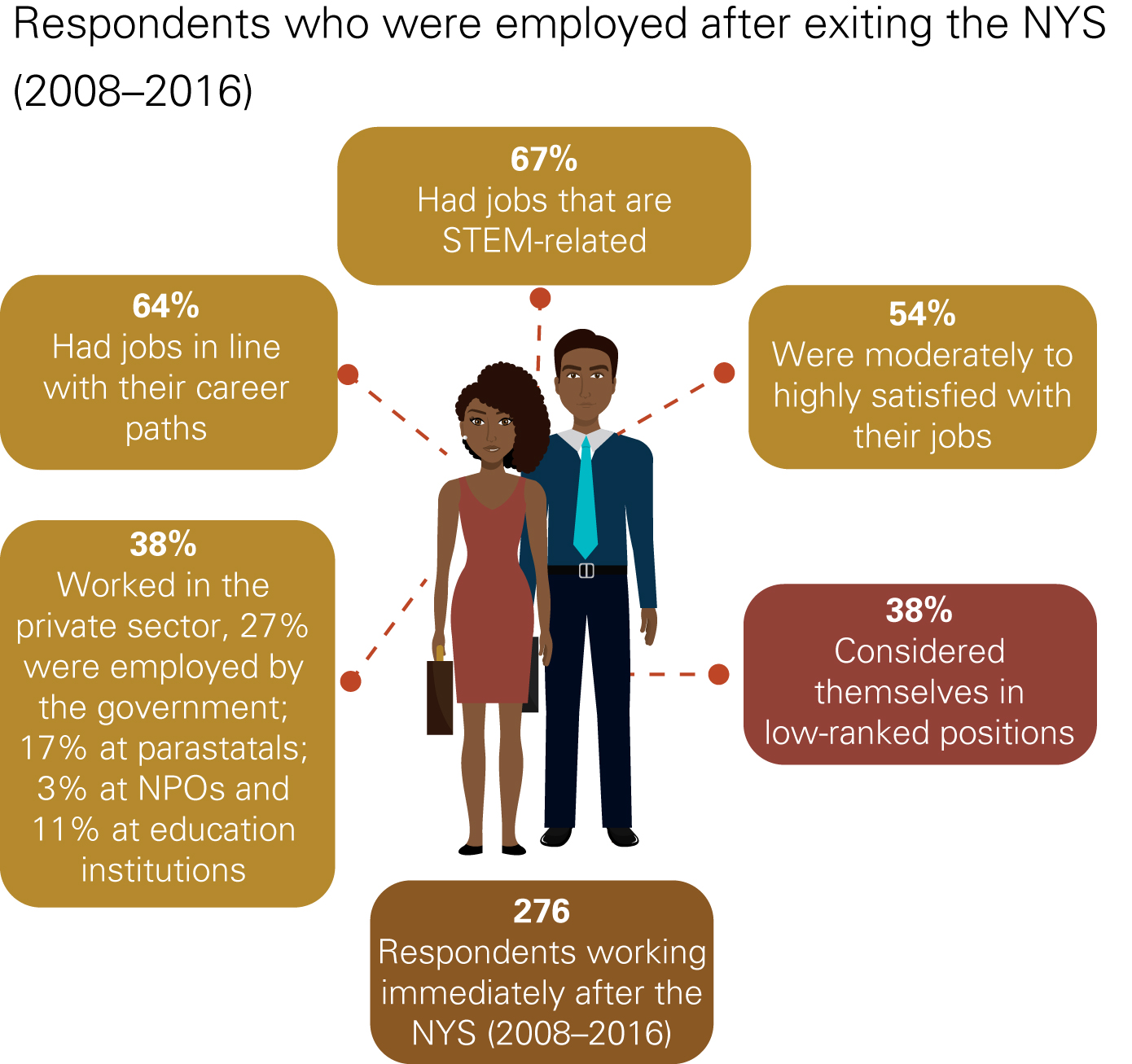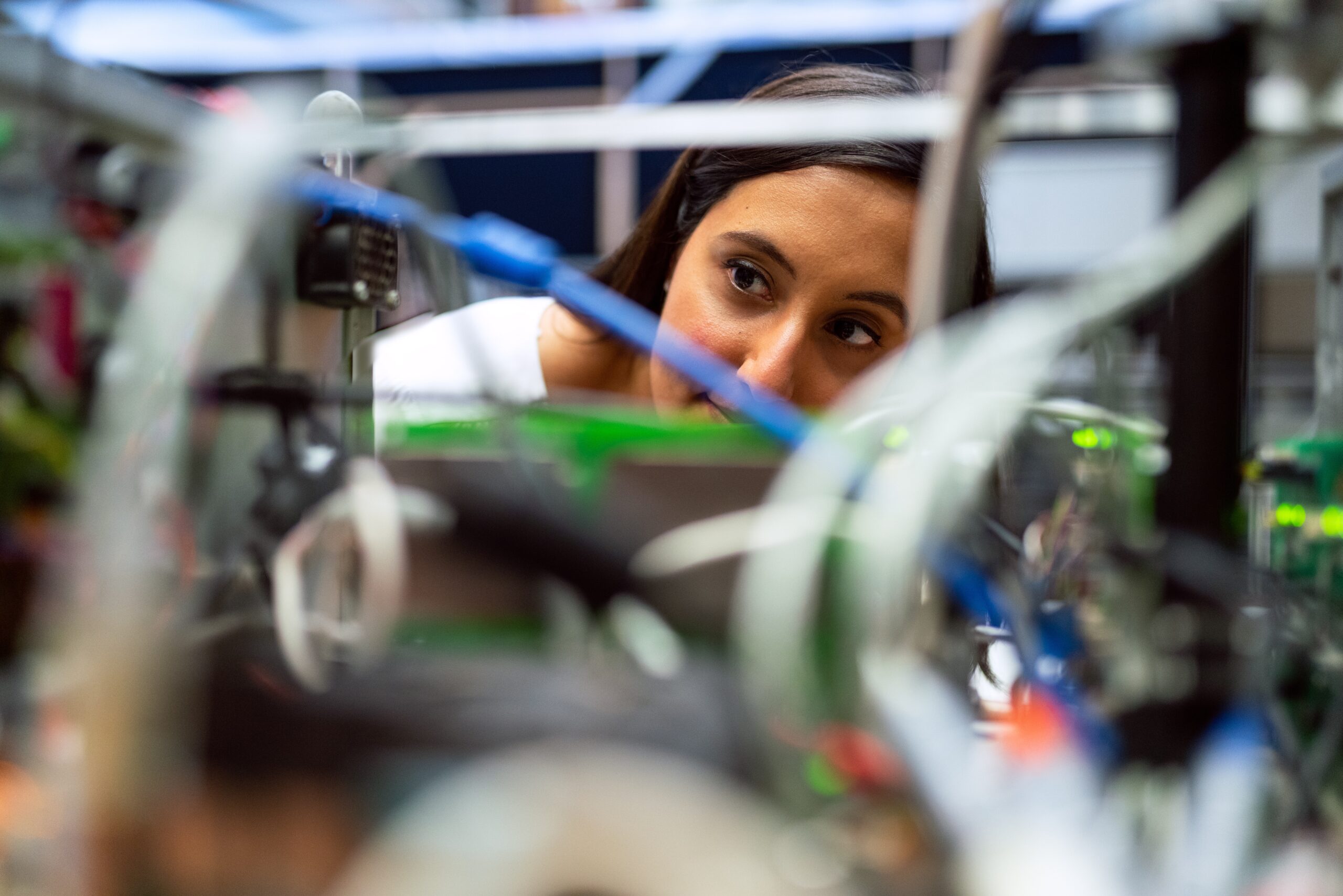
They can’t land a job without experience but won’t gain any experience without a job. This is the devastating realisation of many science graduates who venture into the labour market. The Department of Science and Innovation’s National Youth Service (NYS) programme attempts to bridge this divide by providing workplace experience to people with tertiary qualifications in science, technology and engineering. The HSRC evaluates this programme annually and recently published a 10-year commemorative NYS report. Andrea Juan spoke to the Review.
Many science graduates face hopelessness and disillusionment after investing years of their lives and significant financial resources to obtain a degree. Instead of doors opening, they are unemployed or underemployed. In addition, those from disadvantaged backgrounds have no networks or other resources to fall back on.
The irony is that South Africa experiences skills shortages, especially in science, technology, engineering and mathematics (STEM). Government programmes such as the National Youth Service (NYS) have attempted to assist unemployed STEM graduates by providing workplace experience aligned with their qualifications.
However, for these interventions to have a significant impact, the programmes must be evaluated so they can be improved over time.
HSRC response
Commissioned by the Department of Science and Innovation (DSI), the HSRC has helped to evaluate the NYS programme’s success by conducting an annual tracking study of participants since 2012.
“As Africa’s largest dedicated social science and humanities research agency, the HSRC is well placed to conduct such evaluations,” says Andrea Juan, a senior research specialist in the HSRC’s Equitable Education and Economies research division.
“Our annual evaluation of the programme helps the DSI to continuously assess its effectiveness and quality.”
Based on data collected from 1,321 participants, the HSRC recently compiled a 10-year commemorative report on the NYS programme. Researchers contacted participants during their first year in the programme and then for two subsequent years. The report summarises participant profiles, what they gained from the programme, their employment outcomes and how host institutions benefited. The researchers also conducted in-depth qualitative interviews with some of the original NYS programme participants.

Are we reaching those most in need?
A demographic profile of participants helps the DSI ensure that the programme benefits those most in need. Most of the young people in the programme were black and female, about a quarter (26%) had completed a diploma and 74% had a bachelor’s degree or higher qualification. The majority had graduated in the areas of biology, chemistry, engineering and environmental sciences. However, despite their STEM qualifications, which are listed as scarce skills in South Africa, many were unable to find employment. According to the report, 59% were unemployed, 8% underemployed, 3% working and 30% studying. As 41% of respondents were not unemployed prior to joining the programme, it is evident that the NYS is seen as a way for graduates to access the labour market in any form.
Most of the respondents (63%) indicated that they applied to the NYS programme because they could not find suitable employment due to a lack of work experience. Almost a third also said that there were no suitable job opportunities where they lived. Gaining work experience can be a particular obstacle for individuals whose social and economic positions do not expose them to even casual work opportunities and networks. The NYS programme is designed to overcome these obstacles.
Linked to their studies?
Graduates have been placed at 125 host institutions across the country, including science centres, schools, observatories, zoos and research councils.
The programme aimed to place participants in workplaces where their duties would link to their tertiary qualifications. However, only 18% reported a direct link, 57% an indirect link and 25% said there was no link between their area of studies and the NYS workplace experience.
Initially, participants were recruited for two-year periods with host institutions; however, this was reduced to one year. Some of the participants felt that one year was not enough for people to develop specific interests.
Skills gained
Science communication, interpersonal skills and the ability to work in teams were among the skills that respondents said they gained, while their technical and STEM-related skills were the least improved. The researchers commented that the NYS programme needs to focus more on the latter if they want to assist participants in transitioning into a STEM work environment. Despite this, 71% of respondents said their participation in the programme improved their employability. A further 12% said their employability was ‘enhanced’, but not related to their subject knowledge.
A number of respondents with qualifications in microbiology, biotechnology and environmental science were hosted in science communication positions where they learned about the importance of science promotion, public engagement, administration skills, workshop facilitation, and writing presentations, reports and proposals.
Pathways out of NYS
The researchers collected information from 601 participants on their development pathways after the NYS programme. Half (46%) were employed, 18% were studying and 10% were employed and studying. Twenty-six percent were unemployed. Around two-thirds of the employed had found jobs in STEM-related fields in line with their chosen career paths (Figure 1). Most were employed by the private sector, the government, non-profit organisations, parastatals and educational institutions. More than half were moderately to highly satisfied with their jobs.
Figure 1. Pathways out of the NYS programme


The way forward
The NYS serves as a mechanism through which STEM graduates can make a living and not be lost to the National System of Innovation. As 56% of respondents found employment after participating in the programme, we can argue these STEM graduates were better equipped for their future careers, and more employable. The programme thus allows individuals with little social capital to access labour market networks. Also, placing graduates at science centres and schools where they participated in science communication activities boosted public awareness of science and enhanced the capacity of the science centres.
The researchers recommend that the NYS programme be expanded in terms of the number of participants and that the university criteria be expanded to include those with technical and vocational education and training (TVET) qualifications. Most participants were hosted at government-funded science centres and public schools. The report recommends that the host institutions be expanded to include state-owned enterprises and more private sector organisations, possibly by tapping into the network of host organisations from the Youth Employment Service (YES) programme. YES enables organisations to enhance their B-BBEE levels by providing jobs for young black people, but not necessarily graduates.
Another option is to work with the Sector Education and Training Authorities (SETAs) responsible for managing and creating learnerships, internships, unit-based skills programmes and apprenticeships. A wider network of hosts may provide better matches between NYS participant qualifications and skills to be gained from workplace experiences.

The study highlights the problem of science graduate unemployment, says Juan. “These graduates were sold the idea that a science qualification would be valued in the labour market, but they could not find jobs. This shows how educational qualifications are not enough in terms of the capital that potential employers want. Work experience and networks are just as important.”
Using the feedback from the NYS participants, this HSRC research has identified areas for improvement also summarised in a policy brief. The findings were shared with the DSI, NYS programme developers and host organisations.
“By implementing the suggested changes, the quality of the programme will continue to improve over time, increasing the employability of the participants,” says Juan.
So far, based on the HSRC findings over the years, the NYS programme has been enhanced by broadening the type of host institutions, adding “soft skills” capacity development workshops and mentoring, and by expanding the programme for all graduates (not just STEM). For long-term impact, Juan would like to see the NYS model used by all government departments and shared with other African governments.
Research contact:
Andrea Juan, a senior research specialist in the HSRC’s Equitable Education and Economies research division

